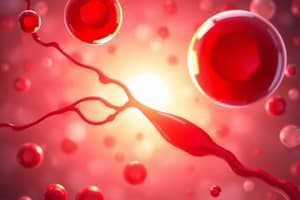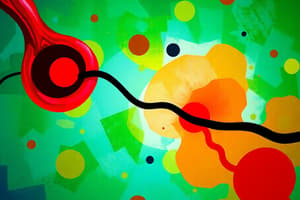Podcast
Questions and Answers
What is the primary function of anti-coagulant drugs?
What is the primary function of anti-coagulant drugs?
- To promote haemorrhage
- To stimulate platelet activation
- To degrade fibrin
- To inhibit development and enlargement of clots (correct)
What is the mechanism of action of heparin?
What is the mechanism of action of heparin?
- By inhibiting the action of platelets
- By promoting haemostasis
- By binding to anti-thrombin III and activating it (correct)
- By degrading fibrin
What is the primary difference between heparin and low molecular weight heparins (LMWHs)?
What is the primary difference between heparin and low molecular weight heparins (LMWHs)?
- Their route of administration
- Their pharmacokinetics
- Their binding affinity to Xa (correct)
- Their mechanism of action
What is the primary indication for the use of heparin?
What is the primary indication for the use of heparin?
What is the antidote for heparin overdose?
What is the antidote for heparin overdose?
What is the laboratory test used to monitor heparin therapy?
What is the laboratory test used to monitor heparin therapy?
What is the primary adverse effect of long-term heparin use?
What is the primary adverse effect of long-term heparin use?
What is the mechanism of action of fondaparinux?
What is the mechanism of action of fondaparinux?
What is the mechanism of action of acenocoumarol?
What is the mechanism of action of acenocoumarol?
What is the pharmacodynamic effect of acenocoumarol in patients with unstable angina?
What is the pharmacodynamic effect of acenocoumarol in patients with unstable angina?
What is the antidote for excessive anti-coagulant effect and bleeding from VKAs like acenocoumarol?
What is the antidote for excessive anti-coagulant effect and bleeding from VKAs like acenocoumarol?
What is the main advantage of direct thrombin (factor IIa) inhibitors and direct factor Xa inhibitors over VKAs?
What is the main advantage of direct thrombin (factor IIa) inhibitors and direct factor Xa inhibitors over VKAs?
What is a common side effect of acenocoumarol?
What is a common side effect of acenocoumarol?
What is the lab control of treatment for acenocoumarol?
What is the lab control of treatment for acenocoumarol?
Study Notes
Haemostasis and Anti-thrombotic Drugs
- Haemostasis is the process that stops bleeding by keeping blood within a damaged blood vessel, with three phases: vascular, platelet, and coagulation.
Classification of Anti-thrombotic Drugs
- Anti-thrombotic drugs interfere with the haemostatic system and are divided into three groups: anti-coagulant drugs, anti-platelet drugs, and fibrinolytics.
Classification of Anti-coagulant Drugs
- Anti-coagulant drugs are divided into:
- Heparin and related drugs (heparin, low molecular weight heparins, fondaparinux)
- Vit K antagonists (warfarin, acenocoumarol)
- Direct thrombin (factor IIa) inhibitors (hirudin, bivalirudin, dabigatran)
- Direct factor Xa inhibitors (rivaroxaban, apixaban, edoxaban)
Heparin and Related Drugs
- Mechanism of action: bind to anti-thrombin III, activating it to inhibit factor Xa and thrombin
- Pharmacodynamics: used in treatment of DVT and pulmonary embolism, unstable angina, or acute MI
- Pharmacokinetics: IV/SC administration, rapid onset, low protein binding, doesn't cross placental barrier
- Side effects: bleeding, thrombocytopenia, autoimmune antibodies against platelets, alopecia, osteoporosis (long-term use)
- Lab control of treatment: APTT (1.5 - 2.5)
- Antidote: i.v protamine sulphate
Vit K Antagonists (Warfarin, Acenocoumarol)
- Mechanism of action: prevent liver synthesis of Vit K-dependent clotting factors and inhibit endogenous anti-coagulants
- Pharmacodynamics: prevent progression/recurrence of acute DVT/pulmonary embolism, venous thromboembolism during orthopaedic surgery, MI in patients with unstable angina
- Pharmacokinetics: oral administration, slow onset of action, high protein binding, 95% cross placental barrier
- Side effects: bleeding, allergic reactions, GI disturbances, skin necrosis
- Excessive anti-coagulant effect and bleeding can be reversed by administering Vit K
- Lab control of treatment: INR (2 - 3)
- Antidote: phytomenadione
- Drug interactions: NSAIDs like aspirin displace acenocoumarol from plasma protein binding sites and enhance their plasma levels
Direct Thrombin (Factor IIa) Inhibitors and Direct Factor Xa Inhibitors
- Mechanism of action: directly bind to thrombin or factor Xa, inhibiting their actions
- Pharmacodynamics: prevention of venous thromboembolism, prevention of stroke and systemic embolism in patients with atrial fibrillation
- Pharmacokinetics: oral administration, rapid onset of action, low risk of interactions with drugs and foods, predictable pharmacokinetics and anti-coagulant effect
- Side effects: bleeding, GI disturbances may occur
Studying That Suits You
Use AI to generate personalized quizzes and flashcards to suit your learning preferences.
Description
Learn about the process of haemostasis, its phases, and the function and classification of anti-thrombotic drugs, including anti-coagulants.





